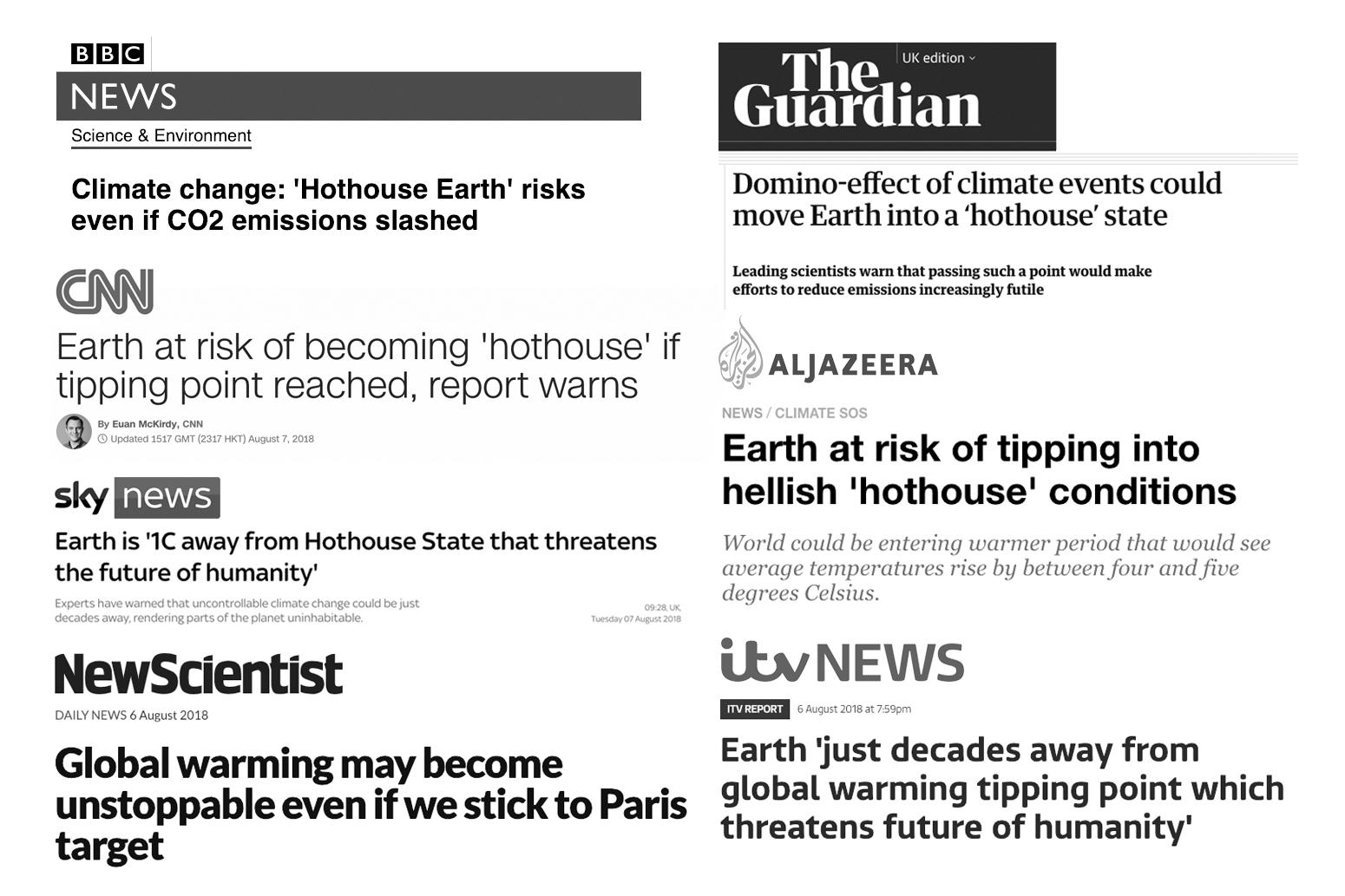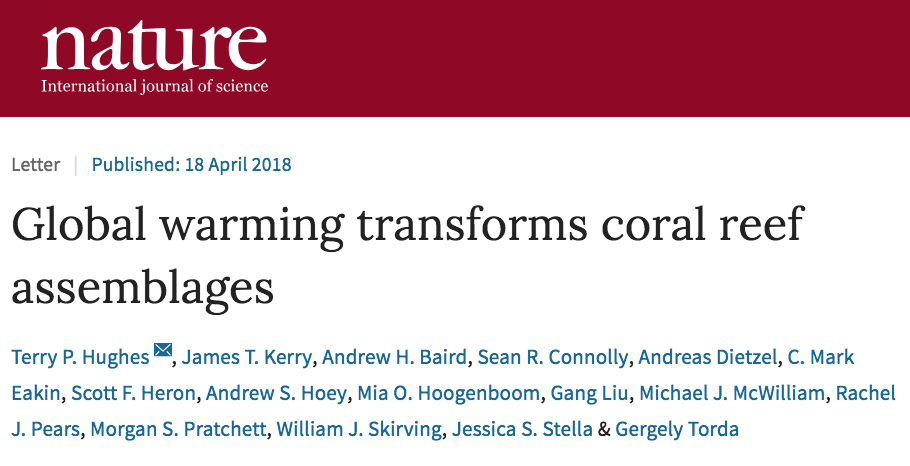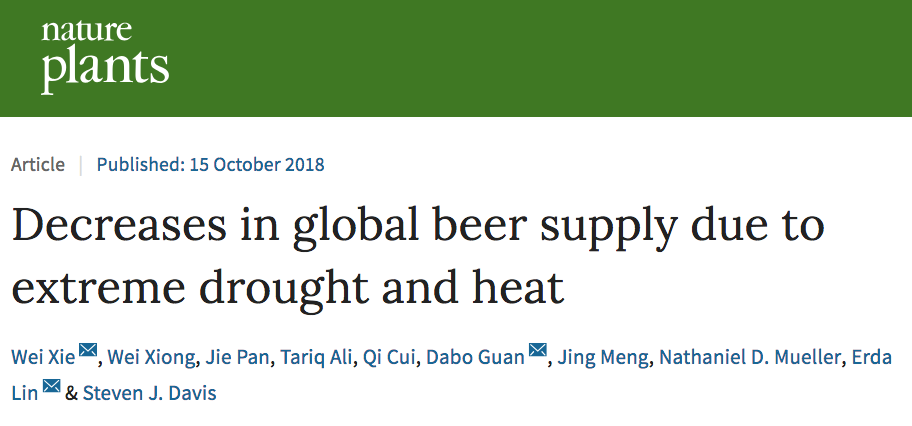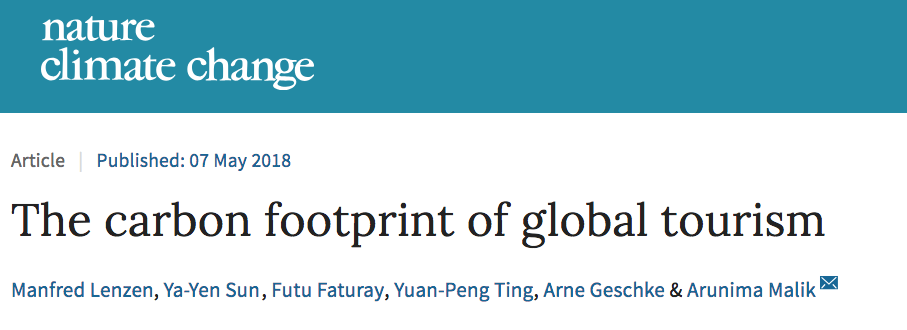The climate papers most featured in the media in 2018
Posted on 21 March 2019 by Guest Author
This is a re-post from Carbon Brief by Robert McSweeney
In a year dominated by events such as Brexit, royal weddings, the Salisbury poisonings, US Supreme Court nominations and the World Cup, there was still space in the news media in 2018 for reporting on new climate research.
These new journal papers were reported around the world in news articles and blogs and shared on social media sites, such as Twitter, Facebook, LinkedIn and Reddit. Tracking all these “mentions” was Altmetric, an organisation that scores and ranks papers according to the attention they receive. (Full details of how the Altmetric scoring system works can be found in an earlier article.)
Using Altmetric data for 2018, Carbon Brief has compiled its annual list of the 25 most talked-about climate change-related papers of the year. The infographic above shows which ones made it into the Top 10.
Top spot
The most talked-about paper last year on any topic, not just climate change, was “Mortality in Puerto Rico after Hurricane Maria”, published in the New England Journal of Medicine. This came first in Altmetric’s Top 100 journal papers of 2018 with an overall Altmetric score of over 10,000.
The press focused on the study’s estimate that the number of deaths in Puerto Rico caused by Hurricane Maria in 2017 was around 70 times higher than official figures. The study received further coverage when US President Donald Trump later tweeted his disagreement after Puerto Rico’s government increased its official death toll.
While the paper is related to climate change – human-caused warming is likely to have played a role in 2017’s unusually active hurricane season – it focuses on mortality statistics rather than the climate. Therefore, it does not it does not make it into Carbon Brief’s list of research papers.
The highest-ranked climate research paper is “Trajectories of the Earth System in the Anthropocene“, published in Proceedings of the National Academy of Sciences (“PNAS”) and led by Prof Will Steffen of the Stockholm Resilience Centre and Australian National University. It accrued an Altmetric score of 6,061.
Widely referred to as the “Hothouse Earth” paper, the study explored the self-reinforcing “feedback loops” that could magnify how the Earth warms in response to rising greenhouse gas concentrations. These feedbacks could push the Earth’s climate beyond a “planetary threshold”, the paper suggests, which – if crossed – could “lock in a continuing rapid pathway toward much hotter conditions”.
The paper was the fifth most talked-about of all journal papers published last year. It was the subject of 460 news stories in 326 outlets, including the Guardian, BBC News, Sky News, New Scientist, Al Jazeera and the Sydney Morning Herald. Links to the paper were also included in 5,392 tweets and 34 Facebook posts.
The Top 5
Falling between this year’s first and second-ranked papers is “The biomass distribution on Earth”, published in PNAS. While its Altmetric score of 4,413 would be enough for second spot and the paper does estimate the carbon stored in the world’s plants and animals, its principal focus is providing “a census of the biomass of all kingdoms of life”. As with the Hurricane Maria paper, it therefore earns an honourable mention rather than a place on the leaderboard.
In second place, published in Nature, is “Global warming transforms coral reef assemblages”. The paper, led by Prof Terry Hughes of the ARC Centre of Excellence for Coral Reef Studies in Australia, warns that corals on the Great Barrier Reef began to die immediately in the aftermath of the record-breaking marine heatwave in 2016.
As Carbon Brief explained when the paper was published in April, this immediate and long-lasting die-off of coral has led to vast swathes of the reef being transformed into “highly altered, degraded systems”, which are now vulnerable to total “ecological collapse”.
Hughes told Carbon Brief that the Great Barrier Reef was changing “faster than any of us anticipated”. Hughes also discussed the prospects for the reef in an in-depth interview with Carbon Brief later in the year.
With a score of 4,392, the study’s total is even higher than the 3,166 scored by Hughes’s paper that came first in Carbon Brief’s 2017 list. The latest paper was covered by 246 news stories from 177 outlets – such as the New York Times, CNN, BBC News, Atlantic, Guardian, Der Spiegel, HuffPost and Forbes. This paper was also tweeted 8,843 times – more than any other in the Top 25.
Taking third place is “Decreases in global beer supply due to extreme drought and heat”, published in Nature Plants. The research, led by Dr Wei Xie of Peking University, warned that drought and extreme heat could reduce yields of barley and cause beer prices to as much as double. While this is “not the most concerning impact of future climate change”, the authors concede, the research shows how rising temperatures could “threaten the availability and economic accessibility of beer”.
The paper’s overall Altmetric score was 3,624. Unsurprisingly newsworthy, the study was the subject of 383 news articles from 318 outlets, including the Hill, New York Times, Guardian, Quartz, Wired and Scientific American. It also featured in 1,413 tweets and on 12 Facebook posts.
In fourth place is the Nature paper “Mass balance of the Antarctic Ice Sheet from 1992 to 2017”. As Carbon Brief reported when it was published, the paper found that rate of sea level rise from melting of the Antarctic ice sheet has tripled over the past five years.
With an Altmetric score of 3,230, this would have been enough to give it top spot last year.
And completing the Top 5 with a score of 2,989 is “Spatial and temporal patterns of mass bleaching of corals in the Anthropocene”, published in Science. The study, published in early January 2018, found that mass coral reef bleaching events have become five times more common worldwide over the past 40 years.
This is another paper from Terry Hughes, giving him two papers in this year’s Top 5, along with last year’s most talked-about study.
Making up the Top 10
Falling outside the Top 5 is the Science paper “Reducing food’s environmental impacts through producers and consumers” in sixth and the Nature Climate Change study “The carbon footprint of global tourism“ in seventh.
The latter paper calculated the carbon footprint of global tourism. As lead author Dr Arunima Malik, a lecturer in sustainability from the University of Sydney, told Carbon Brief, the estimate included quantifying “the impacts of tourist spending on food, clothing, transport and hospitality”. The findings suggested that worldwide tourism accounted for 8% of global greenhouse gas emissions from 2009 to 2013.
In eighth is “The demise of the largest and oldest African baobabs”. This “brief communication” paper in Nature Plants outlined that nine of the 13 oldest of Africa’s baobab trees had died over the past 12 years, and five of the six largest had met the same fate.
These gigantic trees can contain as much as 500 cubic metres of wood and live for almost 2,000 years. In a project that began in 2005, where scientists had identified and dated all of Africa’s baobabs, the researchers found a worrying number had died or “or at least their largest and/or oldest parts/stems have collapsed and died”.
While the “cause of the mortalities is still unclear”, the authors say they “suspect that the demise of monumental baobabs may be associated at least in part with significant modifications of climate conditions that affect southern Africa in particular”.
Completing the Top 10 is “Climate-driven declines in arthropod abundance restructure a rainforest food web”, published in PNAS, in ninth, and the Science paper “Climate model shows large-scale wind and solar farms in the Sahara increase rain and vegetation” in 10th.
Elsewhere in the Top 25
Just missing out on the Top 10 – by a mere 16 Altmetric points – is the Science paper “Declining oxygen in the global ocean and coastal waters”. Oxygen levels in the world’s oceans have fallen over the past half century, the study explained, primarily a result of “increased global temperatures and nutrients discharged to coastal waters”.
Notably in 12th place is the Nature paper “Quantification of ocean heat uptake from changes in atmospheric O2 and CO2 composition”. The study’s main finding – that the oceans have taken up 60% more heat than previously thought – garnered a lot of media attention. However, very shortly after publication, problems with their calculations were spotted by other scientists, principally independent climate researcher Nicholas Lewis.
While these issues did not “invalidate the methodology or the new insights into ocean biogeochemistry on which [the study] is based”, explained co-author Prof Ralph Keeling, they did affect their estimates and uncertainty bounds for average ocean heat uptake. As a result, their “error margins are too big now to really weigh in on the precise amount of warming that’s going on in the ocean”, said Keeling.
The reaction played out in the days immediately following the paper’s publication, generating further online mentions in the news and on social media. (The authors reworked their calculations and submitted a correction to Nature, but this has not yet been published.)
In 13th is “Climate-change–driven accelerated sea-level rise detected in the altimeter era”, published in PNAS, which found that the rate of global sea level rise is accelerating. This is the last paper in the Top 25 with an Altmetric score of more than 2,000. In 2017, only the first five papers reached this milestone, while only one paper managed it in 2016 and 2015.
In 15th and 16th are two papers, both published in February, about iconic creatures that live at the Earth’s poles. The former is the Nature Climate Change study “Climate-driven range shifts of the king penguin in a fragmented ecosystem”, which warned that 70% of king penguins could “abruptly relocate or disappear” by 2100 under a business-as-usual climate change scenario. As Carbon Brief explained when the paper was published, the findings suggest that ocean warming in Antarctica could drive the penguins’ primary hunting grounds further poleward and away from their favoured breeding spots.
The latter paper is the Science paper “High-energy, high-fat lifestyle challenges an Arctic apex predator, the polar bear”, which tracked the movements, metabolism and body conditions of nine female polar bears in the wild. The findings suggested that earlier melting of Arctic sea ice in spring was making it harder for the bears to hunt enough seals to meet their energy demands. Losing weight during the spring months could leave female bears without the resources needed to raise their young, lead author Anthony Pagano told Carbon Brief:
“Basically, they’re not able to provide for their young at an adequate level and that’s driving declines in cub survival.”
Coming to the end of the Top 25 list, a pair of Nature papers are separated by just five Altmetric points. In 24th is “A global slowdown of tropical-cyclone translation speed“ with a score of 1,621. As Carbon Brief explained when the paper was published in June, the research found that the speed at which tropical storms travel across the Earth has slowed by an average of 10% over the past 70 years, allowing them more time to unleash rainfall.
(The paper “Bitcoin’s Growing Energy Problem” in the journal Joule, scored 1,657, which would have been enough to give it 24th spot. However, the article – which discusses the “energy-hungry” way in which Bitcoins are mined – is a commentary and so does not make the list.)
And in 25th place is “Observed fingerprint of a weakening Atlantic Ocean overturning circulation” with a score of 1,616. This was one of a pair of studies published by Nature on the same day that used different approaches to show the ocean circulation system known as the “Atlantic Meridional Overturning Circulation” (AMOC) is now in a weaker state than it has been for decades.
As lead author Levke Caesar told Carbon Brief, it was “very likely” that most of the AMOC slowdown was a result of human-caused warming.
All the final scores for the Top 25 climate papers of 2018 can be found in this spreadsheet.
Journals
And, finally, looking at which journals feature most heavily in the Top 25, Nature has the most papers with eight, followed by Science in second place with six and PNAS and Nature Climate Change in joint third with three each.
In total, 14 papers from the Top 25 were published in journals in the Nature family.
Chart by Carbon Brief using Highcharts































 Arguments
Arguments



































Comments